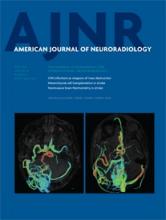In their recent publication “Parent Artery Occlusion in Large, Giant, or Fusiform Aneurysms of the Carotid Siphon: Clinical and Imaging Results,” Labeyrie et al1 retrospectively reviewed 56 patients treated with aneurysm trapping by using detachable platinum coils. The authors make 2 controversial statements, neither of which is referenced, and with which we take issue:
“Proximal occlusion without trapping (surgical or endovascular) has a lower rate of aneurysmal retraction and should not be performed for carotid aneurysms.”
“Endovascular parent artery occlusion with trapping of the aneurysm has long been considered the reference treatment for large, giant, or fusiform aneurysms of the carotid siphon.” [Italics added for emphasis.]
Several large series of giant aneurysms treated with parent artery occlusion have, in fact, demonstrated the safety and efficacy of this treatment alone. Even in the setting of initial retrograde filling, these aneurysms often progress to complete thrombosis. In 1994, Drake et al2 published a series of 160 anterior circulation giant aneurysms treated with Hunterian proximal occlusion. Eighty of 82 petrous and cavernous aneurysms were obliterated with proximal occlusion, only 4 of which required trapping. In 1987, Fox et al3 reported 58 patients with anterior circulation giant aneurysms, with all 37 aneurysms below the ophthalmic segment and 10 of 21 supraclinoid aneurysms obliterated with proximal occlusion alone without the need for trapping. We have been unable to find evidence in the literature demonstrating the inferiority of proximal occlusion as a first-line procedure. Furthermore, the addition of distal occlusion may have contributed to the authors' increased rate of ischemic events in 27% of patients, because the origins of perforating vessels will, by definition, be occluded across any trapped segment. We would argue that proximal occlusion of the parent artery without trapping remains a viable time-honored treatment option for giant saccular and fusiform carotid aneurysms.
- © 2015 by American Journal of Neuroradiology












